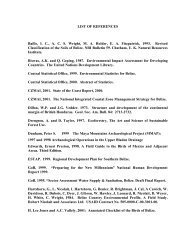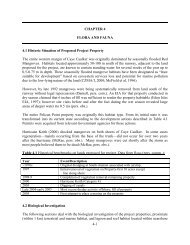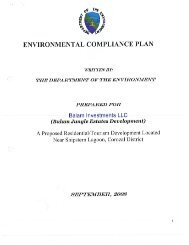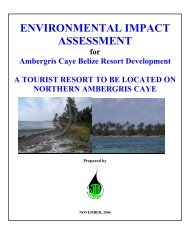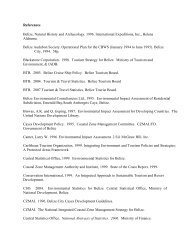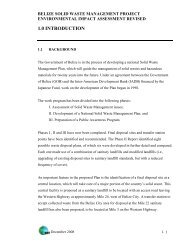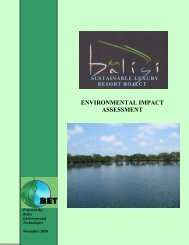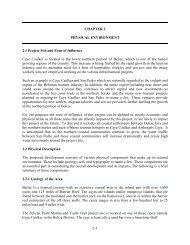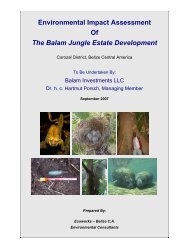Environmental Impact Assessment Of The Mountain Pine Ridge ...
Environmental Impact Assessment Of The Mountain Pine Ridge ...
Environmental Impact Assessment Of The Mountain Pine Ridge ...
You also want an ePaper? Increase the reach of your titles
YUMPU automatically turns print PDFs into web optimized ePapers that Google loves.
<strong>The</strong> total number of staff to be engaged in mining, processing and export will be approximately 120<br />
persons who will be divided approximately equally between the mining and factory site. Potable<br />
water supply for the development will be obtained from a combination of rainwater capture in<br />
cisterns, direct supply from Pinol Creek, and direct supply from the Belmopan municipal water<br />
supply system. Effluent discharge from the development will be treated by septic tank and leach<br />
field facilities. Solid waste management will rely on partial source separation, with combustible and<br />
bio-degradable waste being treated onsite, and all other solid waste being stored at the regional<br />
solid waste storage facility closest to either Cayo or Belmopan, in keeping with the national solid<br />
waste management plan.<br />
WILDLIFE PROFILE AND CONSERVATION PLAN<br />
A rapid biological assessment (RBA) of the proposed development site established that three<br />
habitat types common to the <strong>Mountain</strong> <strong>Pine</strong> <strong>Ridge</strong> region of Belize were extent at the mining site,<br />
which included Woodland and <strong>Pine</strong> <strong>Ridge</strong>; Oak Thicket; and Tiger Fern Thicket. <strong>The</strong> overall<br />
taxonomic diversity of plants on the 40-acre property was low but typical for the ecosystem type(s)<br />
represented, with a combined total of 59 plant species representing 49 genera and 35 families<br />
found to be extent on the property. Wildlife diversity of the project site was equally low but typical<br />
for the ecosystem types represented, with the most important transient species of conservation<br />
interest including a range of Mammals (e.g. Tailed Deer, Baird’s Tapir, Jaguar, Ocelot, and etc.),<br />
along with the year round or seasonal occurrence of some 38 species of birds common to the<br />
<strong>Mountain</strong> <strong>Pine</strong> <strong>Ridge</strong> region of Belize (see Illustration 4). Consequently, development of the<br />
mining site as a granite quarry is not anticipated to create any direct or unmitigated impacts on<br />
wildlife species of particular conservation interest.<br />
LEGAL, POLICY AND ADMINISTRATIVE FRAMEWORK<br />
<strong>The</strong> legal, policy and administrative framework relevant to the proposed development delineate the<br />
obligations and responsibilities of the project proponent as well as those of the Government of<br />
Belize with respect to conservation practice. This framework is loosely embodied by international<br />
conventions and treaties, the laws of Belize (Revised 2000), and policy guidelines developed by<br />
national institutions from time to time.<br />
International Conventions and Treaties<br />
<strong>The</strong>re are a number of international conventions and treaties that Belize has enjoined which are<br />
principally concerned with conservation practices and compliance at the national level (see Table<br />
2). <strong>The</strong> key conventions of particular relevance to the proposed development concern the<br />
International Convention on Biological Diversity, and the Central American Biodiversity<br />
Convention, which specifically address conservation of biodiversity, sustainable use and sharing<br />
the benefits of biodiversity.<br />
<strong>The</strong> <strong>Mountain</strong> <strong>Pine</strong> <strong>Ridge</strong> Granite Quarry EIA / Ecoworks Page 6 of 167




